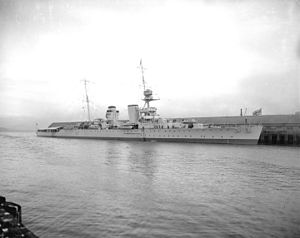Hawkins-class cruiser

|
|
| Class overview | |
|---|---|
| Name: | Hawkins class |
| Operators: |
|
| Preceded by: | None |
| Succeeded by: | County class |
| Built: | 1916 - 1925 |
| In commission: | 1919 - 1949 |
| Completed: | 5 |
| Lost: | 2 |
| Scrapped: | 3 |
| General characteristics | |
| Type: | Heavy cruiser |
| Displacement: |
|
| Length: | |
| Beam: | 58 ft (18 m) (65 ft across bulges) |
| Draught: | 17.25 ft (5.26 m) (20.5 ft (6.2 m) full load) |
| Propulsion: |
|
| Speed: | 31 knots (57.4 km/h) (30 knots (55.6 km/h) Hawkins) |
| Range: | 5,400 nmi (10,000 km) at 14 knots (26 km/h) |
| Complement: | 712 / 750 flag |
| Armament: |
|
| Armour: |
|
| Aircraft carried: | See Vindictive |
The Hawkins class was a class of five heavy cruisers of the Royal Navy designed in 1915 and constructed throughout the First World War. All ships were named after Elizabethan sea captains. The three ships remaining as cruisers in 1939 served in the Second World War, with Effingham being an early war loss through wreck; Raleigh had been lost in a similar shipwreck on uncharted rocks in 1922 (and Vindictive was nearly lost to grounding in 1919). Vindictive, though no longer a cruiser, also served throughout the War. This class formed the basis for the definition of the maximum cruiser type under the Washington Naval Treaty of 1922.
Although the Hawkins class were the first heavy cruisers built for the Royal Navy, they were designed as improved versions of the Birmingham sub-class of the Town-class light cruisers, thus they were initially known as the "Improved Birmingham" type. Their lineage descended through an intermediate sketch design of 1912 known as the "Atlantic Cruiser", armed with a combination of 7.5 and 6-inch (190 and 152 mm) guns, designed to counter reported large German cruisers armed with 7-inch (170 mm) guns.
In 1915, a new design of cruiser was prepared for trade protection on distant waters, for which a heavy armament, long range and high speed was required; meaning a large ship. Previous large cruisers had been of the armoured cruiser or protected cruiser type. These ships had been made obsolete by the adoption of oil-firing and the steam turbine engine and had been superseded by the battlecruiser and the light cruiser. The Hawkins design was basically a light cruiser enlarged sufficiently to increase their range and armament as required. A mixed armament of 9.2 and 6-inch guns was rejected after wartime experience illustrated the difficulty of controlling a mixed battery as shell splashes could not be differentiated. Thus, a uniform battery of 7.5-inch calibre was adopted, controlled by the innovation of director firing.
...
Wikipedia
